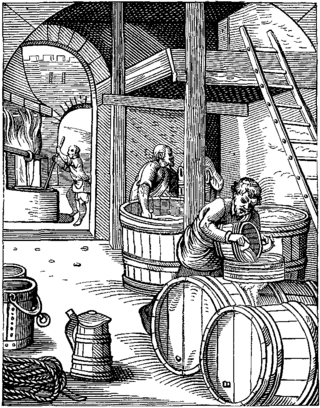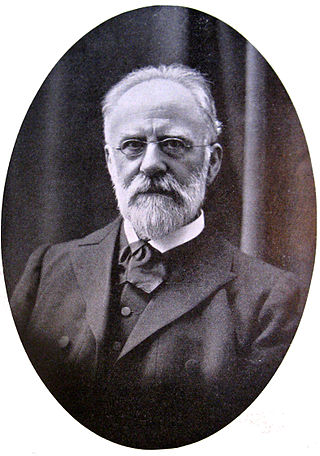
Brewing is the production of beer by steeping a starch source in water and fermenting the resulting sweet liquid with yeast. It may be done in a brewery by a commercial brewer, at home by a homebrewer, or communally. Brewing has taken place since around the 6th millennium BC, and archaeological evidence suggests that emerging civilizations, including ancient Egypt and Mesopotamia, brewed beer. Since the nineteenth century the brewing industry has been part of most western economies.

Yeasts are eukaryotic, single-celled microorganisms classified as members of the fungus kingdom. The first yeast originated hundreds of millions of years ago, and at least 1,500 species are currently recognized. They are estimated to constitute 1% of all described fungal species.

Emil Christian Hansen was a Danish mycologist and fermentation physiologist.

Baker's yeast is the common name for the strains of yeast commonly used in baking bread and other bakery products, serving as a leavening agent which causes the bread to rise by converting the fermentable sugars present in the dough into carbon dioxide and ethanol. Baker's yeast is of the species Saccharomyces cerevisiae, and is the same species as the kind commonly used in alcoholic fermentation, which is called brewer's yeast or the deactivated form nutritional yeast. Baker's yeast is also a single-cell microorganism found on and around the human body.

Saccharomyces cerevisiae is a species of yeast. The species has been instrumental in winemaking, baking, and brewing since ancient times. It is believed to have been originally isolated from the skin of grapes. It is one of the most intensively studied eukaryotic model organisms in molecular and cell biology, much like Escherichia coli as the model bacterium. It is the microorganism behind the most common type of fermentation. S. cerevisiae cells are round to ovoid, 5–10 μm in diameter. It reproduces by budding.

Saccharomyces is a genus of fungi that includes many species of yeasts. Saccharomyces is from Greek σάκχαρον (sugar) and μύκης (fungus) and means sugar fungus. Many members of this genus are considered very important in food production. It is known as the brewer's yeast or baker's yeast. They are unicellular and saprotrophic fungi. One example is Saccharomyces cerevisiae, which is used in making bread, wine, and beer, and for human and animal health. Other members of this genus include the wild yeast Saccharomyces paradoxus that is the closest relative to S. cerevisiae, Saccharomyces bayanus, used in making wine, and Saccharomyces cerevisiaevar. boulardii, used in medicine.
Saccharomyces uvarum is a species of yeast that is commonly found in fermented beverages, particularly those fermented at colder temperatures. It was originally described by Martinus Willem Beijerinck in 1898, but was long considered identical to S. bayanus. In 2000 and 2005, genetic investigations of various Saccharomyces species indicated that S. uvarum is genetically distinct from S. bayanus and should be considered a unique species.

Saccharomycotina is a subdivision (subphylum) of the division (phylum) Ascomycota in the kingdom Fungi. It comprises most of the ascomycete yeasts. The members of Saccharomycotina reproduce by budding and they do not produce ascocarps.

The Carlsberg Research Laboratory is a private scientific research center in Copenhagen, Denmark under the Carlsberg Group. It was founded in 1875 by J. C. Jacobsen, the founder of the Carlsberg brewery, with the purpose of advancing biochemical knowledge, especially relating to brewing. It featured a Department of Chemistry and a Department of Physiology. In 1972, the laboratory was renamed the Carlsberg Research Center and was transferred to the brewery.
Saccharomyces bayanus is a yeast of the genus Saccharomyces, and is used in winemaking and cider fermentation, and to make distilled beverages. Saccharomyces bayanus, like Saccharomyces pastorianus, is now accepted to be the result of multiple hybridisation events between three pure species, Saccharomyces uvarum, Saccharomyces cerevisiae and Saccharomyces eubayanus. Notably, most commercial yeast cultures sold as pure S. bayanus for wine making, e.g. Lalvin EC-1118 strain, have been found to contain S. cerevisiae cultures instead
Yeast flocculation typically refers to the clumping together (flocculation) of brewing yeast once the sugar in a wort has been fermented into beer. In the case of "top-fermenting" ale yeast, the yeast creates a krausen, or barm on the top of the liquid, unlike "bottom-fermenting" lager yeast where the yeast falls to the bottom of the brewing vessel.

Melibiose is a reducing disaccharide formed by an α-1,6 linkage between galactose and glucose. It differs from lactose in the chirality of the carbon where the galactose ring is closed and that the galactose is linked to a different point on the glucose moiety. It can be formed by invertase-mediated hydrolysis of raffinose, which produces melibiose and fructose. Melibiose can be broken down into its component saccharides, glucose and galactose, by the enzyme alpha-galactosidase, such as MEL1 from Saccharomyces pastorianus.

Lager is beer which has been brewed and conditioned at low temperature. Lagers can be pale, amber, or dark. Pale lager is the most widely consumed and commercially available style of beer. The term "lager" comes from the German for "storage", as the beer was stored before drinking, traditionally in the same cool caves in which it was fermented.
Scheffersomyces stipitis is a species of yeast, belonging to the "CUG Clade" of ascomycetous yeasts. This is a group of fungi that substitute serine for leucine when the CUG codon is encountered. S. stipitis is distantly related to brewer's yeast, Saccharomyces cerevisiae, which uses the conventional codon system. Found, among other places, in the guts of passalid beetles, S. stipitis is capable of both aerobic and oxygen limited fermentation, and has the highest known natural ability of any yeast to directly ferment xylose, converting it to ethanol, a potentially economically valuable trait. Xylose is a hemicellulosic sugar found in all angiosperm plants. As such xylose constitutes the second most abundant carbohydrate moiety in nature. Xylose can be produced from wood or agricultural residues through auto- or acid hydrolysis. Ethanol production from such lignocellulosic residues does not compete with food production through the consumption of grain.
Brettanomyces claussenii is a wild yeast of the genus Brettanomyces which has a negative Pasteur effect. It and Brettanomyces anomalus share identical mtDNA. In the wild, it is found on the skins of fruit. It has been shown to be useful for wine and beer fermentation as well as ethanol production.
Saccharomyces eubayanus, a cryotolerant type of yeast, is most likely the parent of the lager brewing yeast, Saccharomyces pastorianus.

The role of yeast in winemaking is the most important element that distinguishes wine from fruit juice. In the absence of oxygen, yeast converts the sugars of the fruit into alcohol and carbon dioxide through the process of fermentation. The more sugars in the grapes, the higher the potential alcohol level of the wine if the yeast are allowed to carry out fermentation to dryness. Sometimes winemakers will stop fermentation early in order to leave some residual sugars and sweetness in the wine such as with dessert wines. This can be achieved by dropping fermentation temperatures to the point where the yeast are inactive, sterile filtering the wine to remove the yeast or fortification with brandy or neutral spirits to kill off the yeast cells. If fermentation is unintentionally stopped, such as when the yeasts become exhausted of available nutrients and the wine has not yet reached dryness, this is considered a stuck fermentation.
Saccharomyces kudriavzevii, is a species of yeast in the Saccharomyces sensu stricto complex. Its type strain is NCYC 2889T. It is used in production of alcoholic beverages, including pinot noir wine, and hybrids of it are used in beer brewing. It is isolated widely from the bark of oak trees.
Aerobic fermentation or aerobic glycolysis is a metabolic process by which cells metabolize sugars via fermentation in the presence of oxygen and occurs through the repression of normal respiratory metabolism. It is referred to as the Crabtree effect in yeast. and is part of the Warburg effect in tumor cells. While aerobic fermentation does not produce adenosine triphosphate (ATP) in high yield, it allows proliferating cells to convert nutrients such as glucose and glutamine more efficiently into biomass by avoiding unnecessary catabolic oxidation of such nutrients into carbon dioxide, preserving carbon-carbon bonds and promoting anabolism.
Lachancea thermotolerans is a species of yeast.









